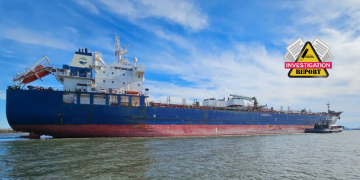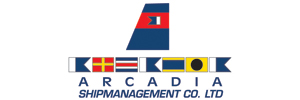The UK MAIB’s latest Safety Digest details a fire on an oil tanker caused by a failed fuel connection, which led to a serious blaze in the engine room but was quickly contained thanks to swift action from the crew.
On a chilly but calm autumnal morning, an oil tanker was approaching its destination berth to discharge a cargo of naphtha, a flammable hydrocarbon mixture used to manufacture fuels and solvents. The bridge team worked together to bring the vessel into position alongside the berth on schedule.
The crew on the mooring boats had just collected the first forward and aft lines and were running them to shore when the tanker’s local fire suppressant system in the engine room activated, triggering the fire alarm. From the engine control room, the chief engineer (C/E) and second engineer (2/E) could see smoke near the combined exhaust/oil-fired boiler. The C/E grabbed a fire extinguisher and started to make their way to the boiler. As they approached, they saw fuel oil running down the side of the boiler and realized something was wrong with the fuel system. The C/E hurried down two ladder flights and stopped the fuel pumps while the crew closed the quick-closing valves on the fuel oil system, causing the ship to lose power. The 2/E started to gather and prepare the engine room fire team.
The master led the coordination of the on-board response to the fire, and the pilot informed the shore authorities. Mooring operations were suspended, tugs were called to stand by the vessel in case the situation worsened, and the local fire and rescue service was notified. The oil tanker’s crew set up boundary cooling, and a fire team made an entry into the engine room, targeting the combined boiler and the lagging below it. Twenty minutes after the initial alarm, the fire was declared extinguished. The oil tanker was later secured to the berth without further incident, where the fire and rescue service confirmed that the fire was out.
The fire started when a connection on the flexible fuel return hose failed where it was joined to the burner unit on the boiler (Figure 1). Fuel from the detached connection sprayed onto adjacent hot surfaces, causing a fire of such intensity that it caused serious damage to the equipment in that area (Figure 2).

Lessons learned
Equipment → The fire was caused by the failure of a flexible hose connection containing fuel under pressure. The history of the hose assembly could not be traced, and it is possible that it had not been changed since the tanker was built. In 2023, the MAIB issued a safety bulletin to emphasize the hazards of such flexible hose installations and highlight that flexible hoses have a higher risk of failure than properly fitted metal pipes. It is vital that flexible hoses are inspected and changed out at regular intervals, and that detailed records are kept.
Action → Early reaction to an alarm can prevent escalation. Once alerted to the fire, both the bridge and engine room teams acted quickly to ensure the safety of the oil tanker, crew, and terminal. The master’s efficient coordination of the individual teams facilitated a quick and early response to the emergency from the very first alarm, and the well-prepared actions taken by the crew prevented a serious situation from becoming catastrophic.
Teamwork → The crew had completed regular drills, including a simulated engine room fire exercise the day before the accident. Practicing various scenarios is an opportunity to develop crew skills, test emergency procedures, and ensure that equipment and systems are in place and working. There is no guarantee that every situation can be brought under control. However, the chances increase substantially when the crew is well-drilled in their individual and collective responsibilities.





























































